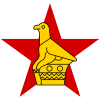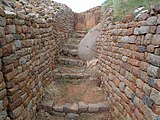| History of Zimbabwe | ||||||||||||||||||||||||||||||||||||||||||
|---|---|---|---|---|---|---|---|---|---|---|---|---|---|---|---|---|---|---|---|---|---|---|---|---|---|---|---|---|---|---|---|---|---|---|---|---|---|---|---|---|---|---|
 | ||||||||||||||||||||||||||||||||||||||||||
Ancient history
|
||||||||||||||||||||||||||||||||||||||||||
White settlement pre-1923
|
||||||||||||||||||||||||||||||||||||||||||
The Kingdom of Butua or Butwa (c. 1425–1683) was a Shona kingdom located in what is now southwestern Zimbabwe. Butua was renowned as the source of gold for Arab and Portuguese traders. The first written record of the kingdom came from Ahmad ibn Majid in 1502.
The kingdom was governed by the Torwa dynasty until 1683 from its capital at Khami. In 1683, the kingdom was conquered by the Rozwi Empire.
The foundations of the Khami Ruins show a striking resemblance to the pattern of masonry at the base of the Zimbabwe Ruins.
History
Foundation and apogee
Khami was originally a Leopard's Kopje site, whose inhabitants are thought to be the ancestors of the Kalanga (southwestern Shona). During the time of Great Zimbabwe's dominance over the region, various offshoots split from it to form various states, one such state being the Mutapa Empire.[a] In the early 15th century Angoche traders opened a new route along the Zambezi via the nascent Mutapa Empire and Ingombe Ilede to reach the goldfields west of Great Zimbabwe, bypassing it. Close to the goldfields, a local Leopard's Kopje chiefdom centred on Khami rose to prominence, contributing to Great Zimbabwe's decline. This was the Kingdom of Butua, with its first mambo (king) Madabhale of the Torwa dynasty, who had the praise name Chibundule (meaning "sounding of the war horn").[b][1]: 50–51
Butua rapidly grew in size and wealth, and came to border the Mutapa Empire along the Sanyati River.[c][3] In 1493, the mambo gifted the Mutapa king 4000 cows and copious amounts of gold. The first written record of Butua came from Ahmad ibn Majid in 1502, who mentioned "Munhu Butua" ("King of Butua"). Due to tales such as that already mentioned, the Portuguese referred to Butua as the "Mother of Gold". The Portuguese traded far into the interior via African merchants, who were noted for their honesty. The Kalanga of Butua were reportedly not war-like (said to rely more on faith in Mwari), and the mambo only mobilised his army in times of war. Women accompanied the army and cooked for them.[1]: 49, 53–54
Demise
The Portuguese invaded Butua in the 17th century and installed a puppet as king, however their influence over the kingdom was short-lived. The 1680s saw the rise of Changamire Dombo as his reputation as a sorcerer and military successes won him followers. In 1683 he conquered the Torwa Kingdom of Butua. His dynasty continued to rule in Butua, adopting the name "Rosvi", until it was destroyed during the 1830s amid the Ngoni invasions.[3]
Government
The mambo had various Councillors (bakadzaxa or makulukota, one of which was head of the royal herds of cattle), minor councillors (basungwaxa), and royal advisors (machinda). He also had a Great Diviner (ng'anga), one of their tasks was rainmaking. Roles were likely hereditary. The mambo had multiple residences for security reasons, with oral traditions mentioning five in and around the Matopos Hills. Cattle played an important role in politics, and the mambo owned many. The government's tribute was collected by sub-chiefs from their people, and gifts were likely distributed, often in the form of loans.[1]: 52
According to Rozvi traditions the Torwa dynasty had the totem of the monkey. Traditions collected in 1922 claim the kingdom covered the territory from Great Zimbabwe to the Makgadikgadi Pan, south to the Crocodile River, and north to the Zambezi, however other traditions say the mambo ruled from Gweru to the Motloutse River.[1]: 51
Society and culture
Ceremonies were held at Khami where people prayed to Mwari for rain. Men sought to marry many wives and have as many children as possible. Produce, skins, and copper could be used to buy cattle and goats, which could then be used to acquire wives. Women sewed skins and furs into blankets, and copper was mined to make jewellery. Gold was mined in people's spare time, usually before planting season[1]: 53–54
Khami features monumental stone structures, which likely symbolised prestige, with reports that the stones were brought to Khami as tribute. Khami's royal palace resembles Leopard's Kopje architecture (specifically Woolandale).[1]: 50, 54
After Changamire's conquest of Butua, the Rozvi did not allow the Portuguese to enter its territory, however they allowed African merchants hired by the Portuguese, termed mussambazes, to trade in Butua.[3]
Economy
Cattle were abundant in Butua, and were an important component of its economy. Cattle were also likely used for loans (a practice called kusaidza). The person who received the loan (kuronzera) could use the cattle as they saw fit and sell its produce, however they could not dispose of them without the owner's permission. The relationship between owner and kuronzera resembled one of vassalage, and served to distribute food and wealth, with the mambo owning most cattle..[1]: 53
Gallery
-
The ruins of Khami, capital of the Butua Kingdom.
-
Steps leading into the ancient city of Khami
-
The outer wall of Khami
See also
Notes
- ^ Oral traditions say that Mutapa's founder, Nyatsimba Mutota, migrated north from Great Zimbabwe, however there isn't any evidence for the same being true of Khami and Butua.
- ^ Kalanga oral traditions collected in 1922 compress the history of the Torwa dynasty into that of one ruler called Chibundule, such that the story of Chibundule represents that of Butua. In a praise poem, Chibundule is said to have given refuge to the elephant (the totem of the Mutapa dynasty) and the rhinoceros (possibly the totem of Mapungubwe's dynasty due to the [[Golden Rhinoceros of Mapungubwe]]).[1]: 51
- ^ Portuguese records from 1520 state that Butua was a vassal of Mwenemutapa, however this is likely to have been falsified in order to portray Portuguese commercial dealings with Mutapa as more important than they were.[2]: 49
References
- ^ a b c d e f g h Waarden, Catrien Van (2012). Butua and the End of an Era: The Effect of the Collapse of the Kalanga State on Ordinary Citizens : an Analysis of Behaviour Under Stress. Archaeopress. ISBN 978-1-4073-1019-0.
- ^ Waarden, Catrien Van (2012). Butua and the End of an Era: The Effect of the Collapse of the Kalanga State on Ordinary Citizens : an Analysis of Behaviour Under Stress. Archaeopress. ISBN 978-1-4073-1019-0.
- ^ a b c Newitt, Malyn (24 May 2018), "Southern Zambezia States and Indian Ocean Trade, 1450–1900", Oxford Research Encyclopedia of African History, doi:10.1093/acrefore/9780190277734.001.0001/acrefore-9780190277734-e-289, ISBN 978-0-19-027773-4, retrieved 18 February 2025
- Gwinn, Robert; Norton, Peter; Goetz, Philip (1989). The New Encyclopædia Britannica. Vol. 2. Encyclopædia Britannica, Inc. p. 689. ISBN 0-85229-493-X.
- Shillington, Kevin (2004). Encyclopedia of African History, Vol. 1. London: Routledge. pp. 1912 Pages. ISBN 1-57958-245-1.












You must be logged in to post a comment.